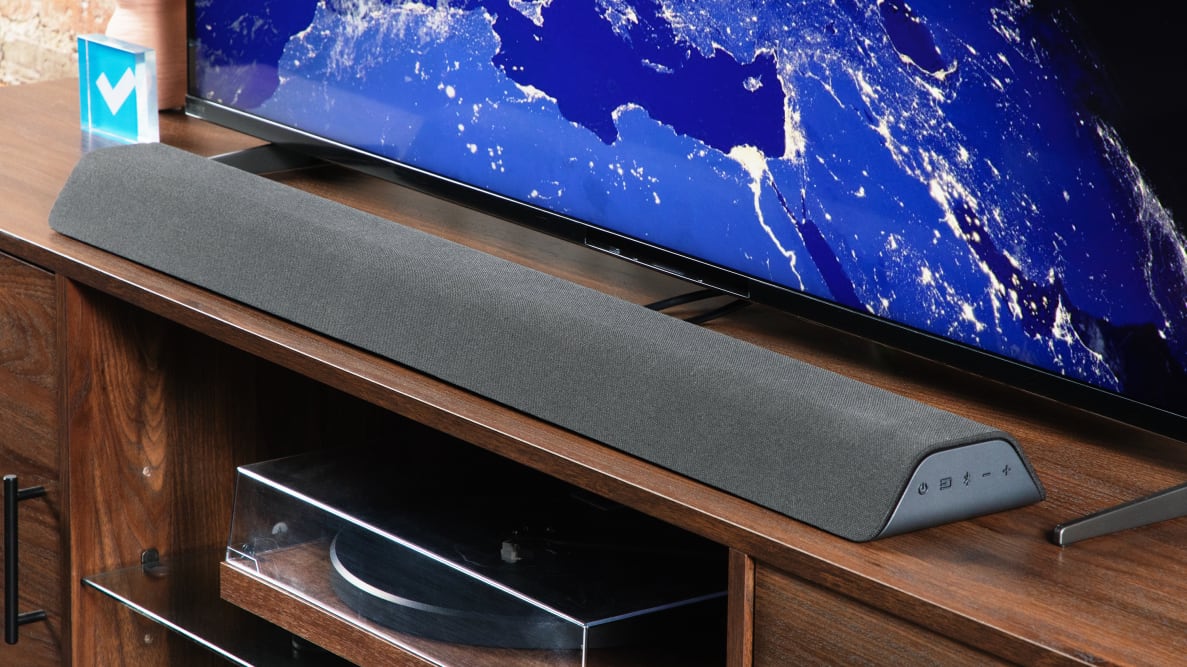Pros
-
Great sound signature
-
Surprisingly good bass
-
Sleek and simple footprint
Cons
-
Below average Dolby Atmos
-
No Wi-Fi
About the Vizio M-Series AiO Soundbar
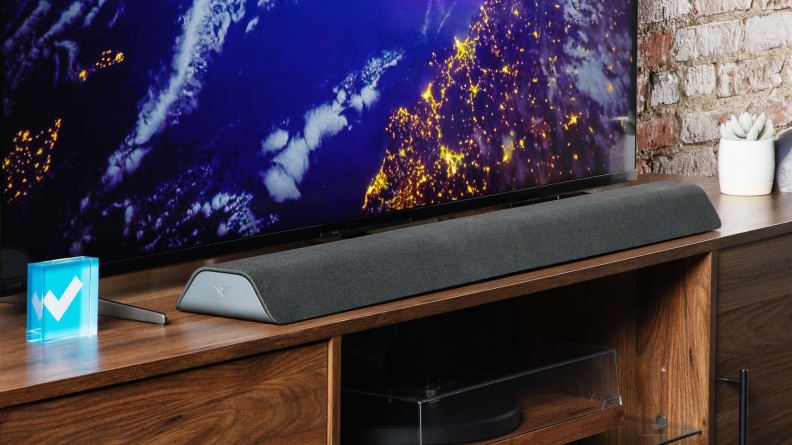
This AiO comes with all the soundbar fixings.
- Price: $179.99
- Height x Width x Depth: 2.13 x 36 x 5.5 inches
- Weight: 5.56 lbs
- Speakers/drivers: two tweeters, two midrange woofers, two built-in subwoofers, two passive radiators
- Wireless connection: Bluetooth 5.2
- Wired connection: One HDMI eARC/ARC, one HDMI input, one digital optical input, one 3.5mm auxiliary input, one 3.5mm stereo input, one USB input
- Sound formats: Dolby Atmos, Dolby Digital Plus, Dolby TrueHD, DTS:X, DTS Virtual: X
- Video support: 4K HDR/Dolby Vision passthrough
There aren’t any intricacies to be made aware of regarding the AiO and what comes with it, and that’s a good thing. Included is what’s now considered to be standard operating accessories—an HDMI cable, a remote (with batteries!) and an operating manual. Once you establish power and a connection to your display, you’re off to the races.
What we like
Impressive sound that complements all kinds of content
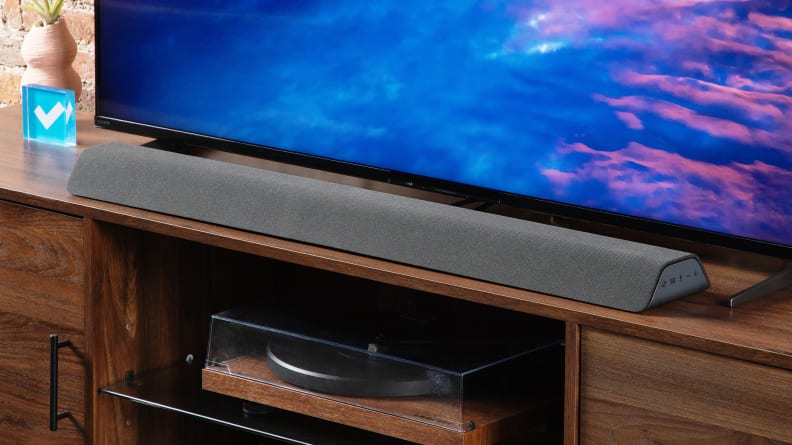
The soundbar produces great sound no matter what's playing.
If you’re going to design a one-stop shop for a soundbar, it’s going to need to be compatible with a vast multitude of content. That’s exactly what the M-Series AiO is.
The timing for my review unit could not have been better, as I had the opportunity to audition everything from the NFL Playoffs to the first few episodes of The Last Of Us, with some binging of That 90s Show and some casual house-cleaning music listening tossed into the mix. Everything—action-heavy sequences, important dialogue, soothing melodies—was extremely well-executed, especially for a sub-$200 bar. And with controls on the Vizio remote for bass, treble, and night mode (where dynamic sound is dampened and dialogue gets an uptick), some light fine tuning was possible during rare instances when the AiO missed the mark.
A button on the remote meant to boost dialogue exclusively would have been a welcomed addition, albeit an understandable omission since the AiO doesn’t have a center channel. Even without that, though, Vizio’s latest all-in-one showcased an adaptive soundstage that sounded great across a wide variety of content.
Decent bass, somehow

There's some surprisingly good low end here for an all-in-one.
All-in-one soundbars notoriously lack bass, and that’s not really a coincidence. Even though many claim to be 2.1-channel systems, as the Vizio does, a subwoofer crammed into a bar simply doesn’t have enough air space to create any significant thump. That was the case with the previous M-Series all-in-one, and I was fully prepared for that to be the case here.
Imagine my surprise, then, when I found the M-Series AiO to have some actual low end. It’s not going to shake your foundation by any means, but it added some noteworthy weight to action sequences in The Last of Us or bass-heavy tracks from artists like Kendrick Lamar or Childish Gambino.
Traditional 2.1-channel soundbars with separate subwoofers will continue to have the edge in the bass department, especially when considering options like the Klipsch Cinema 400 or Polk Audio Signa 2. That being said, Vizio included a pair of frequency response charts in its press kit that compared bass from the M-Series AiO to its own V-Series 2.1 system, revealing strikingly similar output. They may not have completely cracked the code just yet, but the technology is gradually improving for the little subwoofers in these all-in-one solutions.
It presents a sleek, straightforward experience
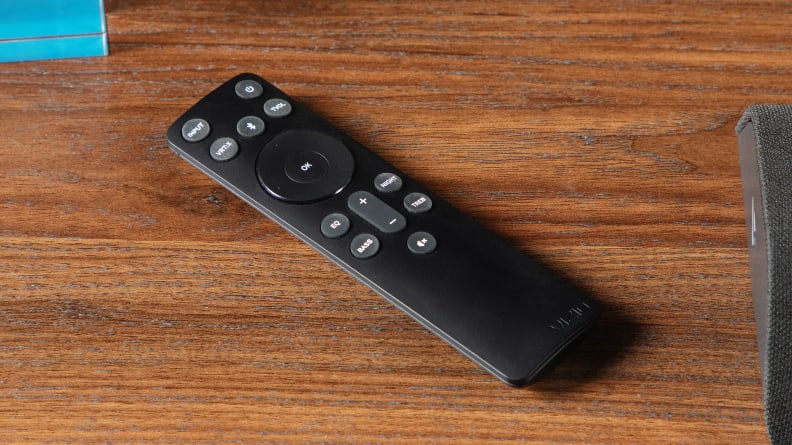
The remote has all the controls you'd want.
Outside of the inclusion of Dolby Atmos and DTS: X (more on that later), there isn’t a lot of pomp and circumstance surrounding the M-Series AiO. Instead, it sports a minimalistic, yet sharp footprint with an equally simple setup process. For reference, I asked a friend with incredibly limited A/V experience to unbox and set up the AiO while I was doing a few household chores. He had the bar unpacked, connected to both the TV and power and ready for the first round of the NFL Playoffs in about five minutes.
This is no surprise given Vizio’s track record, but it’s also remarkably straightforward to use. The included remote has (almost) all the controls you could ask for, allowing you to easily swap out different preset EQs (Movie, Music, Game, Direct, and Dialogue), toggle the bass or treble as needed, change inputs, and mute the bar at a moment’s notice. You won’t have the ability to really tinker with the sound the way some audiophiles may prefer. But for the use case of an all-encompassing setup like the AiO, it’s exactly the streamlined soundbar that it needed to be.
What we don’t like
Dolby Atmos ain’t up to par
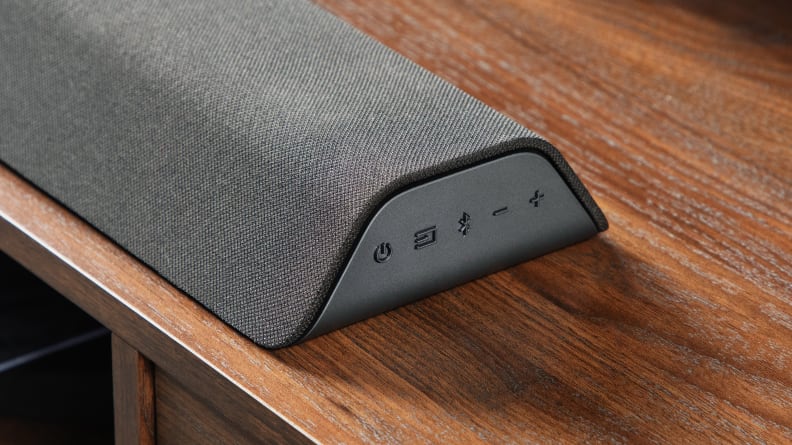
The Dolby Atmos experience is flat-out subpar in this AiO.
Dolby Atmos was a curious inclusion to a 2.1-channel soundbar that retails for $180 and doesn’t, in fact, have dedicated height channels to utilize. The odds were against the AiO in that respect, especially considering there are so few examples of decent Dolby Atmos under $500, let alone the $200 water mark. But I gave the AiO the benefit of the doubt, and sampled several Atmos scenes to see what I could find.
Not much, as it turns out. Big, cinematic moments that had been hits with other Atmos bars, such as clips from Blade Runner 2049 or Interstellar, had disappointing results in the Atmos department. Even Vizio’s own suggestion, the opening scene of Mad Max: Fury Road, was underwhelming, though I could at least start to see what they were getting at.
It doesn’t help that the AiO doesn’t have any way to manually boost height levels via the remote, on account of actual height channels being nonexistent in the soundbar. Even the ability to redline height response, though, wouldn’t have saved a lackluster Atmos experience in what is otherwise a wonderfully capable soundbar.
Wi-Fi, where art thou?
I will die on this hill, even as more and more soundbars seem to abandon the feature altogether. But the AiO is without Wi-Fi, meaning your only independent music streaming option is Bluetooth. Of course, Bluetooth 5.2 connectivity is far better in terms of quality than previous interactions of the technology. But Wi-Fi is still the king when it comes to retaining great streaming sound.
More than sound quality, though, Wi-Fi is essential for continuous, automatic updates that can keep a soundbar’s software up to speed. Why the AiO passed on Wi-Fi and its proven added benefits, but then tried to fashion a Dolby Atmos experience out of a 2.1-channel bar is beyond my comprehension.
Should you buy it?
Yes, but only if Atmos doesn’t matter
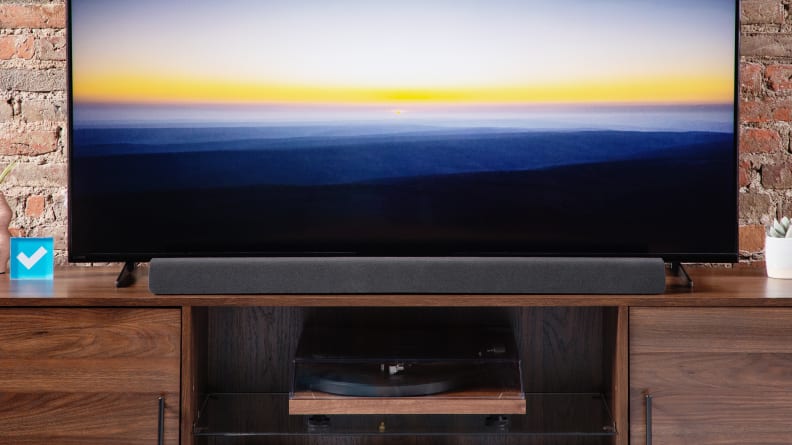
If peak Dolby Atmos experience isn't a requirement, this soundbar may just be for you.
In so many respects, Vizio’s M-Series AiO is an exquisite example of what all-in-one soundbars can do. It presents great sound across all kinds of content, delivered in a package that’s stealthy and incredibly easy to use. And, in an unexpected twist, it puts out an impressively decent amount of bass considering its stature.
Basically, you just have to ignore the Dolby Atmos logo on the M-Series’ box. There are fleeting moments where you can find some extra immersion in what the AiO has to offer. But for the most part, it isn’t a capable Atmos soundbar. The closest (somewhat) near this price range include the Polk Signa S4 and the Vizio M-Series 5.1.2, which are markedly more expensive, but offer some of the most affordable, authentic Atmos on the market today.
If you can forget about Atmos, though, you’ll see the M-Series AiO for the solid, all-in-one solution that it is.

Vizio’s M-Series all-in-one soundbar, the M213AD-K8, is one of the best soundbars for under $200.
Meet the tester
Nick Woodard is a tech journalist specializing in all things related to home theater and A/V. His background includes a solid foundation as a sports writer for multiple daily newspapers, and he enjoys hiking and mountain biking in his spare time.
Checking our work.
Our team is here to help you buy the best stuff and love what you own. Our writers, editors, and experts obsess over the products we cover to make sure you're confident and satisfied. Have a different opinion about something we recommend? Email us and we'll compare notes.
Shoot us an email
